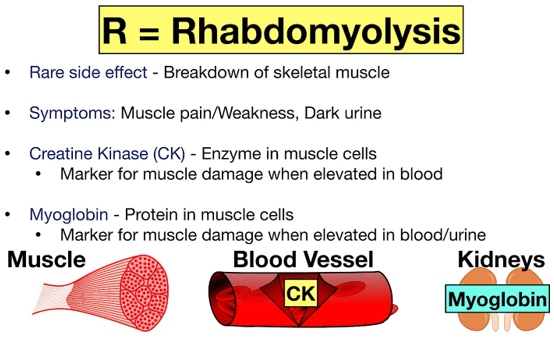A nurse is reinforcing teaching with a client who has a new prescription for atorvastatin.
For which of the following adverse effects should the nurse instruct the client to monitor and report to the provider?
Hypoglycemia
Palpitations
Daytime drowsiness
Muscle pain
The Correct Answer is D
d. Muscle pain.
Atorvastatin is a medication used to lower cholesterol levels in the blood. One of the potential adverse effects of atorvastatin is myopathy, a condition characterized by muscle pain, weakness, and tenderness. In severe cases, myopathy can progress to rhabdomyolysis, a potentially life-threatening condition in which muscle breakdown products are released into the bloodstream and can cause kidney damage.
Therefore, the nurse should instruct the client to monitor for muscle pain, weakness, or tenderness and report these symptoms to the healthcare provider immediately. Hypoglycemia, palpitations, and daytime drowsiness are not commonly associated with atorvastatin use and would not require immediate reporting to the healthcare provider.

Nursing Test Bank
Naxlex Comprehensive Predictor Exams
Related Questions
Correct Answer is C
Explanation
Bacterial meningitis is a serious infection of the membranes surrounding the brain and spinal cord that can cause inflammation and damage to the nervous system.
Nuchal rigidity refers to stiffness and pain in the neck that makes it difficult to flex the neck forward. This finding is indicative of inflammation of the meninges and is a classic sign of meningitis.
Pedal edema refers to swelling of the feet and ankles and can be caused by various conditions such as heart, liver, or kidney problems.
Jaundice refers to yellowing of the skin and eyes and can be caused by liver or bile duct disease.
Hematuria refers to the presence of blood in the urine and can be caused by various conditions such as urinary tract infections, kidney stones, or bladder cancer. These findings are not related to bacterial meningitis and may suggest other health concerns that require further evaluation and management.
Correct Answer is A
Explanation
Pantoprazole is a proton pump inhibitor (PPI) used to reduce stomach acid production and treat conditions such as gastroesophageal reflux disease (GERD). Taking pantoprazole before a meal is generally recommended to optimize its effectiveness.
Remaining upright for at least 1 hour after taking the medication helps prevent the medication from refluxing back into the oesophagus. This position allows the medication to reach the stomach and be absorbed properly.
Taking the medication on an empty stomach is not necessary, as it can be taken with or without food. However, it is generally recommended to take it before a meal for better absorption.
Experiencing diarrhea is not a common side effect of pantoprazole. If diarrhea occurs and persists, the client should contact their healthcare provider.
Antacids should not be taken at the same time as pantoprazole. Antacids can interfere with the absorption of pantoprazole, so it is advised to take them at least 2 hours apart.
Whether you are a student looking to ace your exams or a practicing nurse seeking to enhance your expertise , our nursing education contents will empower you with the confidence and competence to make a difference in the lives of patients and become a respected leader in the healthcare field.
Visit Naxlex, invest in your future and unlock endless possibilities with our unparalleled nursing education contents today
Report Wrong Answer on the Current Question
Do you disagree with the answer? If yes, what is your expected answer? Explain.
Kindly be descriptive with the issue you are facing.
